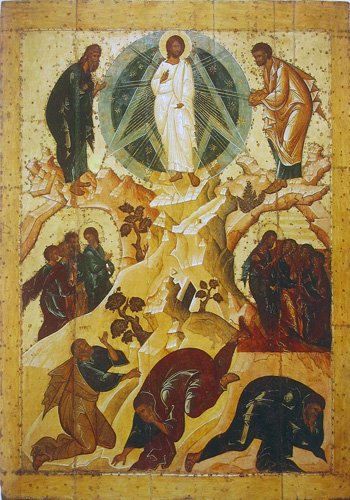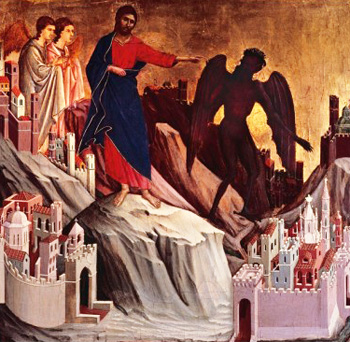Feast Days of Our Lord
 |
 |
 |
 |
 |
 |
 |
The Transfiguration of Our Lord Jesus Christ
August 6
St. Thomas Aquinas comments that in the Transfiguration "the whole Trinity appeared: the Father in the voice, the Son in the man, the Spirit in the luminous cloud.” (1) Today´s liturgy, however, emphasizes that the Transfiguration is like a grand culmination of the preaching of Christ.
 It is also the counterpart to the temptations He suffered in the desert. In the desert the Devil tempted Him; here, at the Transfiguration, two saints accompany Him. There, Satan quoted the Law and the Prophets to tempt Him; here, the most important representatives of the Law and the Prophets appear alongside Him to support Him. There, He was hungry and humbled; here, He appears full of glory and power. There, He showed that He was a man; here, He shows that He is God.
It is also the counterpart to the temptations He suffered in the desert. In the desert the Devil tempted Him; here, at the Transfiguration, two saints accompany Him. There, Satan quoted the Law and the Prophets to tempt Him; here, the most important representatives of the Law and the Prophets appear alongside Him to support Him. There, He was hungry and humbled; here, He appears full of glory and power. There, He showed that He was a man; here, He shows that He is God.
Christ was transfigured to give to His disciples – and to us – a glimpse of the glory of Heaven, so they no longer wanted to leave from there, although at first they felt fear, which is a characteristic of "imaginative visions."
Indeed, St. Teresa says that imaginative visions "at the beginning cause great fear and, then, immediately you feel peace and joy." Christ appeared to her showing only His hand and she fell to the ground. But, then, little by little He showed Himself to her until she could see Him completely. If He had done this from the first moment, she could not have endured it. She said that if one were to spend all his life contemplating that vision, as the three Apostles wanted to do, one could die of joy.
In fact, according to tradition, Our Lady passed from this world to the next because Christ put an end to the continuous miracle that prevented her from dying of the joy she felt because of her immense love for God.
The Apostles needed this miracle to withstand the sufferings and persecutions they were going to receive in the name of Christ. Although this episode of the Transfiguration is sublime, it is intimately linked to the Passion: Christ spoke with Moses and Elias of His Passion and, immediately after, on the descent from the mountain He announced to His disciples the sufferings He would have to pass through.
You cannot have true faith without remembering both the Passion and the Glory of Christ: that He is Man and God. It is important to note that these same Apostles – Peter, James and John – were also chosen by Christ to witness His Passion in the Garden of Olives, (2) as well as the resurrection of the daughter of Jairus. (3) Christ taught the value of His voluntary sacrifice, accepting the “chalice” and letting himself be "squeezed like an olive" (Gethsemane = גת שמנים = oil press), but, He also told us " to fear not" because He has the power to overcome death (the resurrection of the girl) because He is God.
Speaking about the Resurrection, which was prefigured in the Transfiguration, St. Paul says: "If Christ be not risen again, then is our preaching vain, and your faith is also vain." (4)
Six days after Peter’s confession
St. Matthew notes the exact time when this miracle took place: "six days later." Six days after what? After the confession of St. Peter who recognized Jesus as the Son of God and after Christ announced for the first time His Passion and Death.
To confirm the Apostles in the dogmas of His Divinity and Humanity, Our Lord had asked the disciples what the people said about the Son of Man. As we know, the contemporaries of Christ thought that He was a simple man.
"Who do men say that the Son of man is? (5) He asked the Apostles. And, then, was when St. Peter made his confession: "Thou art Christ, the Son of the living God" (6)
 But St. Peter had to recognize not only the Divinity of Christ, but also His human nature and accept His Passion and Death. The Jews, who until that day could not accept the mystery of the Incarnation, committed the same sin as their father, the Devil, who replied "Non serviam" (לֹא אעבוד) when it was revealed to him the Incarnation of the Divine Word and His birth from a Woman.
But St. Peter had to recognize not only the Divinity of Christ, but also His human nature and accept His Passion and Death. The Jews, who until that day could not accept the mystery of the Incarnation, committed the same sin as their father, the Devil, who replied "Non serviam" (לֹא אעבוד) when it was revealed to him the Incarnation of the Divine Word and His birth from a Woman.
Therefore, Our Lord, immediately after the confession of St. Peter, predicted His Passion and, after six days, He transfigured himself to confirm His disciples in the faith.
The Transfiguration also tells us something about our Resurrection: Our flesh will be resurrected with the glorious characteristics of impassibility, lightness, subtlety and radiance, like the resurrected body of Christ. That is, the body can no longer suffer: "God shall wipe away all tears from their eyes: and death shall be no more, nor mourning, nor crying, nor sorrow shall be any more," (7) says the Apocalypse. The glorious bodies will be able to move anywhere at will: to enter a closed room with its doors locked, as Christ entered the Cenacle on the day of the Resurrection, (8) and they will possess the greatest beauty.
But, for now we are still in the battle and we have to continue to act. We cannot pretend to make three huts and sit down to rest just to contemplate God and enjoy His presence. Certainly we must contemplate Christ, but we must continue to act: That is why we always have to descend from the mountain.
May God give us the grace to stand firm, fighting the good fight of faith, doing all we can so that Christ reigns, and also trusting in His Divine Will and the powerful intercession of His Blessed Mother for all that we cannot achieve by ourselves. Amen.


The counterpart to the Transfiguration of Our Lord is his temptation in the desert

Christ was transfigured to give to His disciples – and to us – a glimpse of the glory of Heaven, so they no longer wanted to leave from there, although at first they felt fear, which is a characteristic of "imaginative visions."
Indeed, St. Teresa says that imaginative visions "at the beginning cause great fear and, then, immediately you feel peace and joy." Christ appeared to her showing only His hand and she fell to the ground. But, then, little by little He showed Himself to her until she could see Him completely. If He had done this from the first moment, she could not have endured it. She said that if one were to spend all his life contemplating that vision, as the three Apostles wanted to do, one could die of joy.
In fact, according to tradition, Our Lady passed from this world to the next because Christ put an end to the continuous miracle that prevented her from dying of the joy she felt because of her immense love for God.
The Apostles needed this miracle to withstand the sufferings and persecutions they were going to receive in the name of Christ. Although this episode of the Transfiguration is sublime, it is intimately linked to the Passion: Christ spoke with Moses and Elias of His Passion and, immediately after, on the descent from the mountain He announced to His disciples the sufferings He would have to pass through.
You cannot have true faith without remembering both the Passion and the Glory of Christ: that He is Man and God. It is important to note that these same Apostles – Peter, James and John – were also chosen by Christ to witness His Passion in the Garden of Olives, (2) as well as the resurrection of the daughter of Jairus. (3) Christ taught the value of His voluntary sacrifice, accepting the “chalice” and letting himself be "squeezed like an olive" (Gethsemane = גת שמנים = oil press), but, He also told us " to fear not" because He has the power to overcome death (the resurrection of the girl) because He is God.
Speaking about the Resurrection, which was prefigured in the Transfiguration, St. Paul says: "If Christ be not risen again, then is our preaching vain, and your faith is also vain." (4)
Six days after Peter’s confession
St. Matthew notes the exact time when this miracle took place: "six days later." Six days after what? After the confession of St. Peter who recognized Jesus as the Son of God and after Christ announced for the first time His Passion and Death.
To confirm the Apostles in the dogmas of His Divinity and Humanity, Our Lord had asked the disciples what the people said about the Son of Man. As we know, the contemporaries of Christ thought that He was a simple man.
"Who do men say that the Son of man is? (5) He asked the Apostles. And, then, was when St. Peter made his confession: "Thou art Christ, the Son of the living God" (6)

After his confession of Christ's divinity,
Peter received the keys of power
Therefore, Our Lord, immediately after the confession of St. Peter, predicted His Passion and, after six days, He transfigured himself to confirm His disciples in the faith.
The Transfiguration also tells us something about our Resurrection: Our flesh will be resurrected with the glorious characteristics of impassibility, lightness, subtlety and radiance, like the resurrected body of Christ. That is, the body can no longer suffer: "God shall wipe away all tears from their eyes: and death shall be no more, nor mourning, nor crying, nor sorrow shall be any more," (7) says the Apocalypse. The glorious bodies will be able to move anywhere at will: to enter a closed room with its doors locked, as Christ entered the Cenacle on the day of the Resurrection, (8) and they will possess the greatest beauty.
But, for now we are still in the battle and we have to continue to act. We cannot pretend to make three huts and sit down to rest just to contemplate God and enjoy His presence. Certainly we must contemplate Christ, but we must continue to act: That is why we always have to descend from the mountain.
May God give us the grace to stand firm, fighting the good fight of faith, doing all we can so that Christ reigns, and also trusting in His Divine Will and the powerful intercession of His Blessed Mother for all that we cannot achieve by ourselves. Amen.
- St. Thomas Aquinas: “Tota Trinitas aparuit, Pater in voce, Filius in homine, Spiritus Sanctus in nube clara” Summa Theologiae, III. Q45. A4.
- Mt 26: 36-45
- Lk 8:51-56
- I Cor. 15:14
- Mt 16:13
- Mt 16:16
- Apoc 21:4
- Jn 20:19

Posted August 7, 2017
______________________
______________________
 Volume I |
 Volume II |
 Volume III |
 Volume IV |
 Volume V |
 Volume VI |
 Volume VII |
 Volume VIII |
 Volume IX |
 Volume X |
 Volume XI |
 Special Edition |


